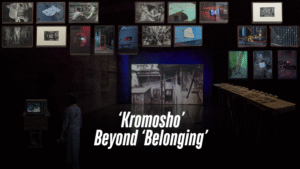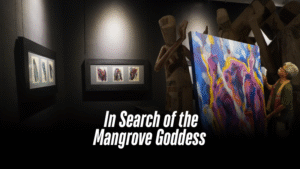Day: April 23, 2025

‘Kromosho’: Beyond ‘Belonging’
In the middle of the 2000s, a young Munem Wasif started sifting through Old Dhaka’s veins with his aged friend Zenit—a mechanical artifact from the Soviet era. His 2012 photography masterwork “Belonging,” which would revolutionize visual storytelling in Bangladesh’s art scene, was the culmination of a journey that began with this. Similar to the constantly flowing dark waters of Buriganga, which has seen Dhaka undergo changes, Wasif’s own artistic endeavors have veered through several stages throughout time. His work has continuously pushed audiences to look past the obvious, from “Seeds Shall Set Us Free” to “Collapse.” But despite all of these adventures, one thing stayed the same: his strong, unwavering bond with Old Dhaka. Munem Wasif is doing a solo show in Dhaka after nearly 16 years. Titled “Kromosho,” the show is currently ongoing at the capital’s Bengal Shilpalay. Tanzim Wahab served as the exhibition’s curatorial advisor, Iftekhar Hassan as a project assistant, and Dehsar Works as the architectural designer. It is open to everyone and will end on May 31, 2025. “I felt like something was lacking as soon as ‘Belonging’ was released. I felt that I just got the surface of the people and their celebrations; I couldn’t reach the core of their daily existence, the ‘life’ of Puran Dhaka. That’s when I thought of creating “Kheya”l. This exhibition is like a testament to my last two decades of transformation,” remarked Wasif when asked about “Kromosho”. The opening at Bengal Shilpalay was buzzing with energy as art lovers gathered to witness what promises to be one of the most memorable exhibitions in recent times. The exhibition unfolds like a carefully composed symphony in three movements. Starting from Wasif’s ethereal black-and-white photographs from the ‘Belonging’ era, now in dialogue with new color works from ‘Stereo.’ This juxtaposition creates a fascinating tension between past and present, memory and reality. At ‘Kheyal,’ the filmic meditation about what pulses through Old Dhaka’s veins. At ‘Shamanno’ and ‘Paper Negative,’ the installations blend documentation with imagination, challenging our perceptions of what is real and what is remembered. From a critical viewpoint, Old Dhaka represents a ticking time bomb—overcrowded and decaying, it’s an ugly relic of our greed and collective neglect. But Wasif’s work reveals depths hidden in plain sight: the “life” amongst all these. Beyond the obvious chaos lies a world of hidden poetry. This is what ‘Kromosho’ captures so brilliantly—not just images of a place, but its very essence. The exhibition becomes a mirror, asking questions about what we preserve and what we discard in our relentless march toward modernity. In an age of rapid urbanization and cultural amnesia, Wasif’s work serves as both archive and elegy, reminding us of some stories that cannot be captured through cameras or words. To experience its truest essence, you have to be there in flesh and psyche. As visitors move through the gallery, they’re invited not just to see, but perhaps to introspect. In this sense, ‘Kromosho’ transcends being merely an art exhibition; it becomes a conversation, a homecoming, and, most importantly, a call to witness.
Read More
Foshan Uniceramics Expo — Asia’s Largest Industry Showcase Concludes with Resounding Success
2025 Foshan Uniceramics Expo Concludes Successfully, Global Ceramic Industry Gathers for the Event. From April 18 to 22, the 2025 Foshan Uniceramics Expo was successfully held at the Foshan Tanzhou International Convention and Exhibition Center. As the biggest ceramics expo in Asia and a benchmark for the industry, this year’s event brought together over 600 brands from the ceramic, sanitary ware, and equipment & materials sectors, covering the entire industrial chain and showcasing the world’s most cutting-edge new products, designs, technologies, equipment, and materials. For this year’s exhibition, the international participation reaches new heights. 2025 Foshan Uniceramics Expo attracted overseas brands from Italy, Turkey, Japan, Germany, Australia, and other countries, with Indonesian ceramic brands making their debut as a group. The equipment and materials section highlighted its international appeal, featuring continued participation from leading companies in Italy, Germany, Turkey, and other nations, along with new exhibitors from additional countries. Moreover, professional buyers from 85 countries and regions attended, including distributors, traders, engineering firms, and ceramic manufacturers, further solidifying the exhibition’s global influence. Foshan Uniceramics Expo remains committed to its mission of “Bridging world ceramics to China, and China’s ceramics to the world.” Moving forward, it will continue to foster deeper exchanges and cooperation in the global ceramics industry, injecting new vitality into its international development. Stay tuned for the next edition!
Read More
In Search of the Mangrove Goddess
Exploring the Sundarbans’ cryptic mangroves may be a weird, larger-than-life experience. When danger occurs in this wide wilderness, instinct frequently prompts one to seek spiritual protection. In such cases, the Sundarbans’ guardian spirit—Bon Bibi or Bono Bibi—is invoked. Bon Bibi is revered by the local forest dwellers as the divine guardian of the region’s treacherous environment. From April 4 to April 20, the Kalakendra gallery at the capital’s Lalmatia featured “In Quest of Bono-Bibi,” a mixed-media solo exhibition by artist Saidul Haque Juise. Juise, known for his precise craftsmanship, bright masks, and three-dimensional compositions, returned with a solo display following a long absence. Bon Bibi’s mythology is unique in that it combines both the Islamic and Hindu traditions, and it is commonly held that invoking her name in times of crisis promises divine assistance. The stories related to Bon Bibi are woven in a rich tapestry of mythology, which prodded Juise’s psyche when he was a child. Later in life, deeply touched by the Sundarbans’ environmental deterioration, he created this body of work as a lament and devotion to nature. This anthology, with its recurring themes of environmental concern and political overtones, combines lyrical extracts from folklore or shloks related to Bon Bibi with his own storytelling. The birth of these artworks dates back to the COVID pandemic. A time when despair loomed large. It was during this emotional upheaval that the artist Juise channeled his sorrow, frustration, and fear into a series of expressive sketches. Using vibrant shades of black, green, red, and blue— which are reminiscent of traditional Bangladeshi folk pottery— Juise stained his pages with raw emotion. Later, by combining various materials, such as twisted metal wires, paint, ink, handmade paper, newspaper pieces, etc., Juise enhanced the series even further. He was able to convey Bon Bibi’s holy force and the forest’s ethereal essence through these components. His line drawings smoothly blend with his pen and ink pieces to create complex collages that have a vibrant yet delicate vibe. In the meanwhile, the collection gains a tactile, even unearthly quality from his wire sculptures. The series gives viewers a deep feeling of Bon Bibi’s pervasive atmosphere. Along with his technical finesse, Juise added a unique Bengali flavor to the pieces. He skillfully combined the forms of people, animals, and insects to create flowing silhouettes that convey both motion and motionlessness. These shapes convey a duality: sadness that is subdued yet evident and fury that is controlled but strong. In doing so, Juise creates a collection of work that is both visually pleasing and profoundly significant by balancing artistic form with emotional weight. “In Quest of Bono-Bibi” stands much like an artistic diary that procures the artist’s personal reflections, cultural memory, and the urgent call for ecological reverence. It bridges folklore and modernity, spirituality and artistry—ultimately offering a visual testament of healing and harmony between humans and the natural world.
Read More
